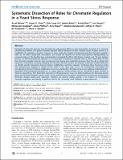Systematic Dissection of Roles for Chromatin Regulators in a Yeast Stress Response
Author(s)
Weiner, Assaf; Chen, Hsiuyi V.; Liu, Chih Long; Rahat, Ayelet; Klien, Avital; Soares, Luis; Gudipati, Mohanram; Pfeffner, Jenna; Regev, Aviv; Buratowski, Stephen; Pleiss, Jeffrey A.; Friedman, Nir; Rando, Oliver J.; ... Show more Show less
DownloadWeiner-2012-Systematic Dissectio.pdf (8.120Mb)
PUBLISHER_CC
Publisher with Creative Commons License
Creative Commons Attribution
Terms of use
Metadata
Show full item recordAbstract
Packaging of eukaryotic genomes into chromatin has wide-ranging effects on gene transcription. Curiously, it is commonly observed that deletion of a global chromatin regulator affects expression of only a limited subset of genes bound to or modified by the regulator in question. However, in many single-gene studies it has become clear that chromatin regulators often do not affect steady-state transcription, but instead are required for normal transcriptional reprogramming by environmental cues. We therefore have systematically investigated the effects of 83 histone mutants, and 119 gene deletion
mutants, on induction/repression dynamics of 170 transcripts in response to diamide stress in yeast. Importantly, we find that chromatin regulators play far more pronounced roles during gene induction/repression than they do in steady-state expression. Furthermore, by jointly analyzing the substrates (histone mutants) and enzymes (chromatin modifier deletions) we identify specific interactions between histone modifications and their regulators. Combining these functional results with genome-wide mapping of several histone marks in the same time course, we systematically investigated the correspondence between histone modification occurrence and function. We followed up on one pathway, finding that Set1-dependent H3K4 methylation primarily acts as a gene repressor during multiple stresses, specifically at genes involved in ribosome biosynthesis. Set1-dependent repression of ribosomal genes occurs via distinct pathways for ribosomal protein genes and ribosomal biogenesis genes, which can be separated based on genetic requirements for repression and based on chromatin changes during gene repression. Together, our dynamic studies provide a rich resource for investigating
chromatin regulation, and identify a significant role for the ‘‘activating’’ mark H3K4me3 in gene repression.
Date issued
2012-07Department
Massachusetts Institute of Technology. Department of BiologyJournal
PLoS Biology
Publisher
Public Library of Science
Citation
Weiner, Assaf et al. “Systematic Dissection of Roles for Chromatin Regulators in a Yeast Stress Response.” Ed. Jerry Workman. PLoS Biology 10.7 (2012): e1001369.
Version: Final published version
ISSN
1544-9173
1545-7885